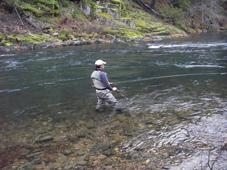Update on TNUF’s Fish DNA project and a Separate DNA Project:
As many of you know, through the combined efforts of Board member, Garry Kenny and Board Advisor, Dr. Michael Miller, the design for a Fish DNA counting machine was developed in 2015.
A prototype of the system has been fabricated and was tested at the University of California Davis. Currently a next generation of the system is being designed Dr. Kenny and two Engineers that will be suitable for in-site testing at either Winchester Dam or the Oregon Hatchery Research Center in Alsea, OR. The system will not only count and identify fish but will collect and store DNA samples from fish passing through a fish ladder. Thus allowing subsequent sequencing of the DNA to identify their genome.
A separate project headed by Dr. Miller and Board Advisor Jeff Dose is designed to manually capture fish DNA at various sites in the North Umpqua drainage. A meeting to discuss the project was recently held in Roseburg with representatives from ODFW, Pacific Corp and the USFS. Among several topics discussed was the need for a more in-depth description of sampling design and a description of how statistical analysis would be accomplished – related to sampling design, and the sample size.
There was also discussion of whether the study was intended for determining habitat use, or simply presence/absence of fish. Some commenters thought that perhaps an intensive sampling of a small number of tributaries might be more useful, in lieu of a broader coverage. There was not agreement on this.

The sampling permit has been approved, but additional information is needed for interested parties to agree upon a sampling protocol which is scheduled to begin in May 2017. Questions include: should it be a stratified random sample, and if so, should it include factors such as; elevation, geology, gradient, presence of obstacles, and perhaps other factors.
Lastly, it was suggested that the permit application be amended to include tissue samples from the Soda Springs evaluation facility.
